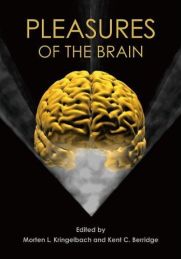A sense of pleasure generated by the brain’s hedonic neural systems is fundamental to daily life and it's been essential for evolution and the survival of humans and most animals, say Morten Kringelbach and Kent Berridge, editors of a new book to be published by Oxford University Press in October 2009 called Pleasures of the Brain.
The Neurobiology Of Pleasure
The rewards we experience through sensations such as food, sex and social interaction are driving forces necessary to maintain life, they argue.
'Pleasure' has been regarded as too subjective to study scientifically and has instead remained in the domain of psychology but since the late 1990s there have been hypotheses that both conscious and unconscious pleasures of rewards are central to affective neuroscience and well-being. Conversely, a lack of it – anhedonia – is considered by some a major feature of mental illness.
Kringlebach, an Oxford University neuroscientist, and Berridge, a psychologist from the University of Michigan, tackle the subject by first asking scholarly experts a series of fundamental questions on the role of pleasure in psychology and in the brain. The experts provide answers to the questions they feel most passionately about, thus revealing the frank and sometimes disparate views that might lead to the best concepts in this newly emerging field of hedonic science.
The rest of the book is divided into three main sections: animal pleasures, human pleasures and clinical applications, with contributions from over 30 European and American experts.
Animal pleasures starts with an overview of research into the hedonic hotspots of the rodent brain that generate a basic sensory pleasure, describes the associated brain regions and concludes with the neuroethology of research into pleasure in non-human primates.
The human pleasure section begins with an exploration of the psychology and evolution of pleasure in people, continuing on with sensory pleasures such as taste, smell and sexual excitement, and culminating in higher pleasures of sociality, music and art. Functional neuroimaging provides the data that link psychology, neuroanatomy and endocrinology necessary for positive emotional experiences. Understanding pleasure is also an important component in the treatment of pain. In the final section on clinical application, the authors outline the neural mechanisms that modulate pain relief through deep brain stimulation, and consider other aspects of the role of pleasure in human psychopathological problems.
At an academic level, Pleasures of the Brain is both a starting point and a reference for more experienced students and scientists in neuroscience, psychology, psychiatry, neurology and neurosurgery. Knowledge of pleasure is essential to progress in the study of human nature and the brain. It may even lead to better ways to enhance our lives.
Refs
and further readingHOME
DAMGO
Thought control?
Hypermotivation
First Brain Prosthesis?
The Orgasm Command-Center
Electrodes in Brain to Switch Off Pain
The Transcranial Magnetic Stimulator
Brain Stimulation and the Shadow Self
Wireheads and Wireheading in Science Fiction
Addicted brains; the chemistry of pain and pleasure
Pleasure Evoked by Electrical Stimulation of the Brain
dave@bltc.com

